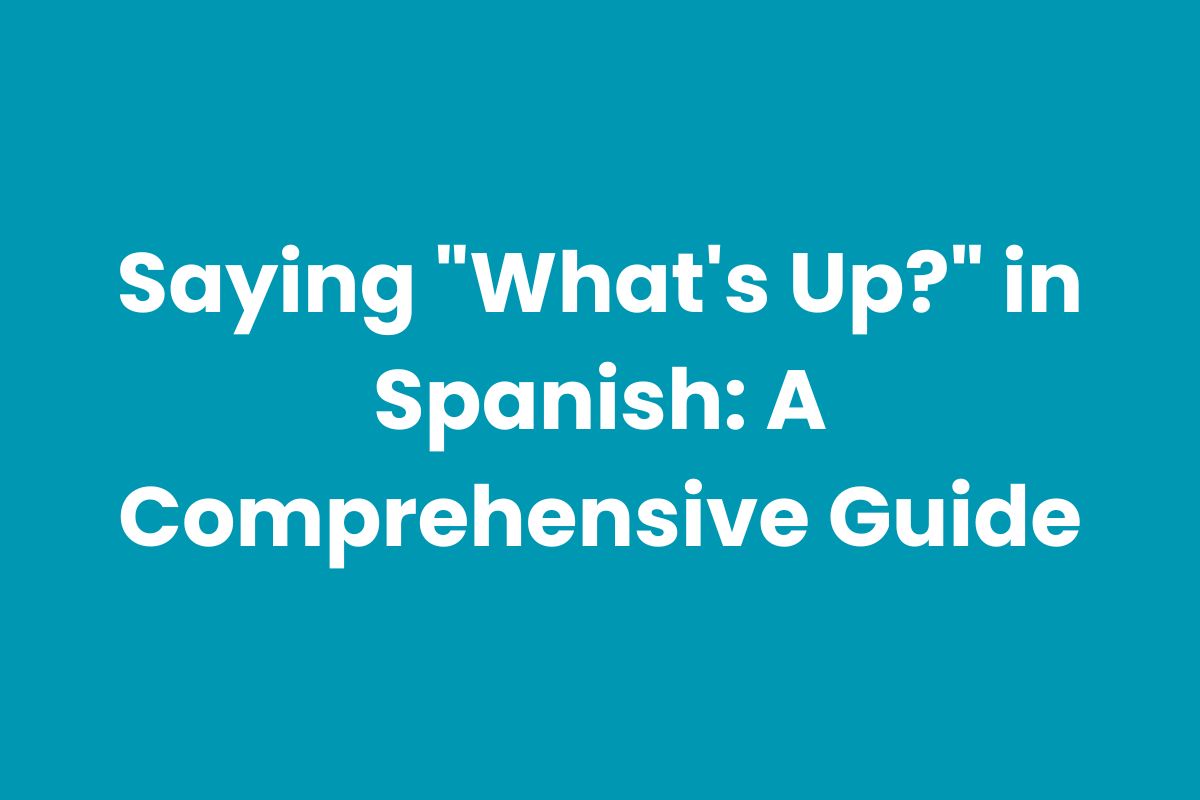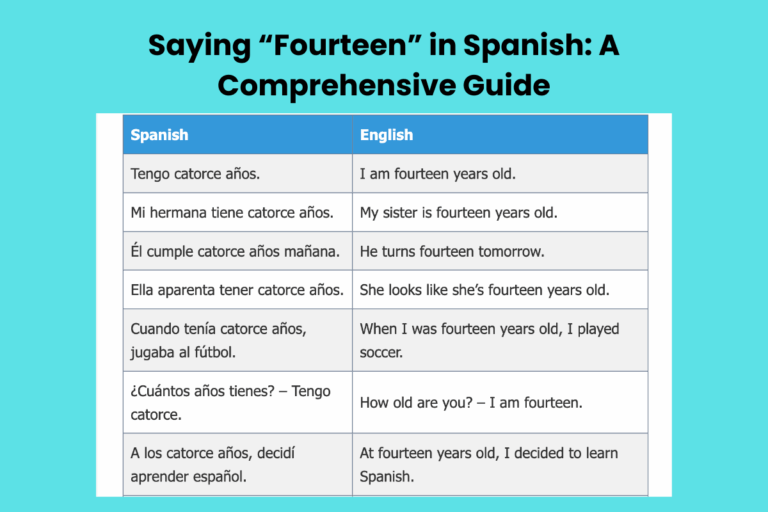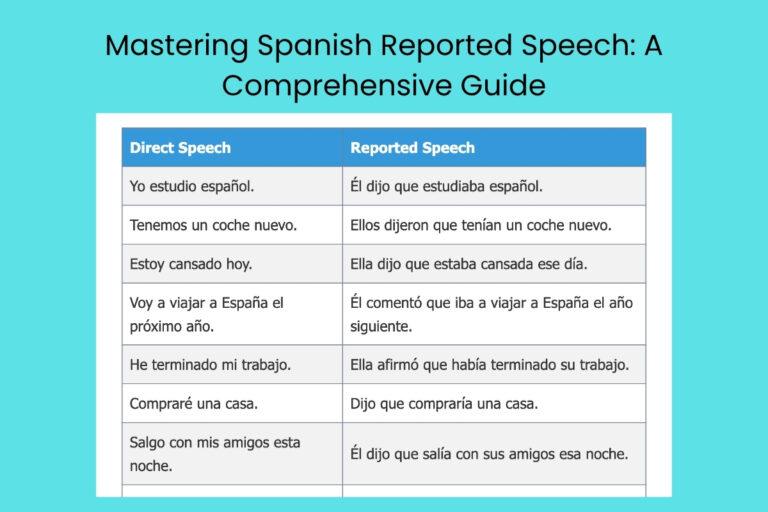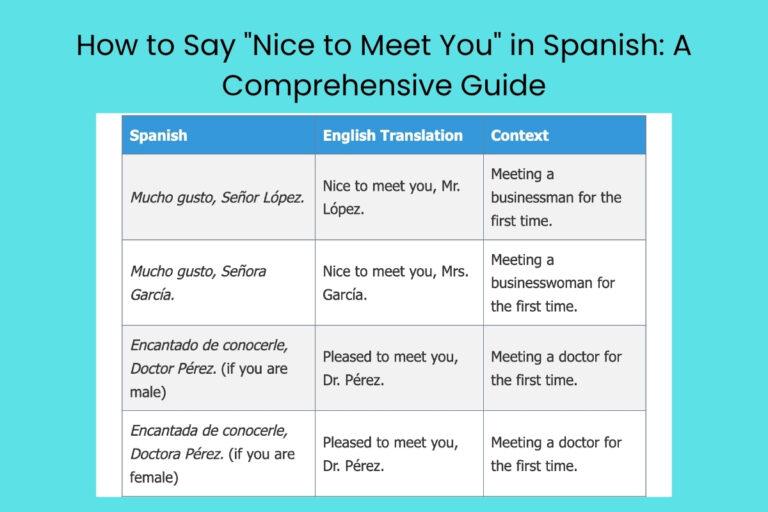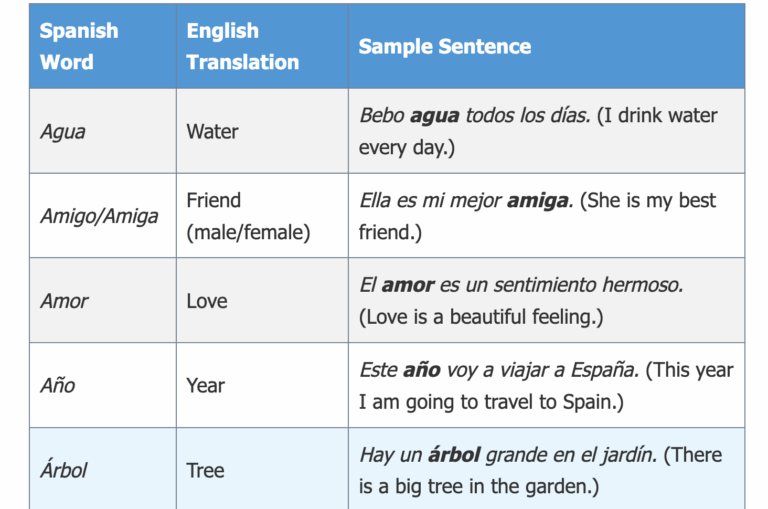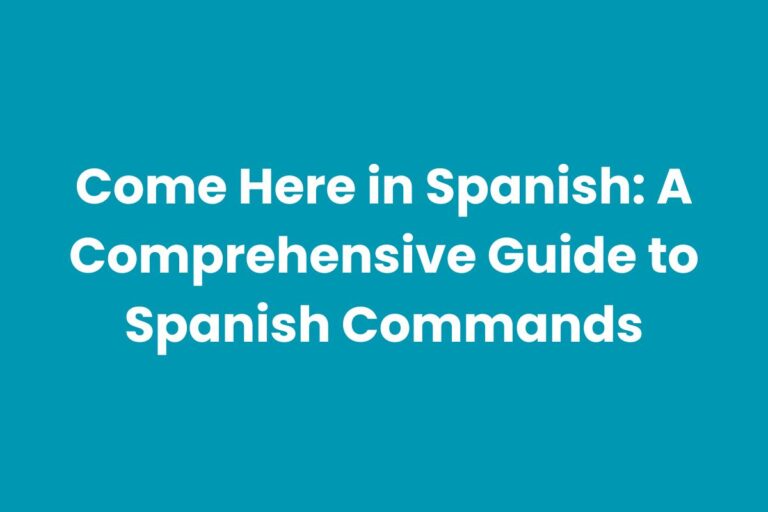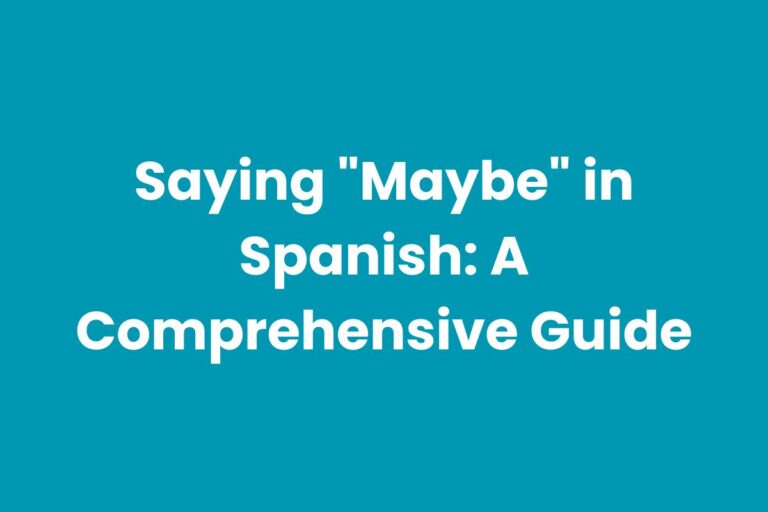Saying “What’s Up?” in Spanish: A Comprehensive Guide
Learning how to greet people and ask “What’s up?” in Spanish is essential for engaging in everyday conversations and building relationships. This seemingly simple question has a variety of translations and nuances depending on the context, region, and level of formality.
Understanding these variations will not only improve your communication skills but also help you navigate social situations with confidence. This guide is designed for learners of all levels, from beginners to advanced speakers, offering a detailed exploration of the different ways to say “What’s up?” in Spanish, along with practical examples, usage rules, and common mistakes to avoid.
Table of Contents
- Introduction
- Definition: What’s Up? in Spanish
- Structural Breakdown
- Types and Categories of “What’s Up?”
- Examples
- Usage Rules
- Common Mistakes
- Practice Exercises
- Advanced Topics
- FAQ
- Conclusion
Definition: What’s Up? in Spanish
The phrase “What’s up?” is a common greeting in English, used to initiate a conversation or simply acknowledge someone’s presence. In Spanish, there isn’t a single direct translation that captures all its nuances.
Instead, several phrases can be used, each with slight differences in meaning and level of formality. These phrases can range from casual inquiries about someone’s well-being to more direct questions about ongoing events or activities.
The appropriate choice depends heavily on the relationship between the speakers, the context of the conversation, and the specific region where the Spanish is being spoken.
Essentially, “What’s up?” in Spanish can be classified as an interrogative greeting. Its primary function is to open a line of communication, similar to “Hello” or “Hi,” but with an added element of inquiry. It invites the other person to share news, express their current state, or simply acknowledge the greeting. The context in which it’s used determines whether it’s a genuine question or a more perfunctory greeting. Understanding these nuances is key to using the appropriate phrase in different situations.
Structural Breakdown
The Spanish phrases used to convey “What’s up?” typically involve interrogative words and verbs related to being, doing, or happening. Understanding the structure of these phrases can help you grasp their meaning and use them correctly.
Here’s a breakdown of the common elements:
- ¿Qué?: This is the most common interrogative word, meaning “What?” It’s used to ask about things or situations.
- ¿Cómo?: This interrogative word means “How?” and is used to ask about someone’s well-being or the way things are going.
- Estar: This verb means “to be” and is often used in phrases asking about someone’s current state or condition.
- Pasar: This verb means “to happen” or “to occur” and is used in phrases asking about what’s going on.
- Hacer: This verb means “to do” and can be used to ask about what someone is doing or planning to do.
Combining these elements, we can form various phrases that convey “What’s up?” For example:
- ¿Qué pasa?: “What’s happening?” or “What’s going on?”
- ¿Qué tal?: “What’s up?” or “How’s it going?”
- ¿Cómo estás?: “How are you?” (more personal)
The structure of these phrases is relatively simple, but the context and intonation can significantly affect their meaning. Pay attention to how native speakers use these phrases to get a better understanding of their nuances.
Types and Categories of “What’s Up?”
The Spanish language offers a variety of ways to say “What’s up?” catering to different levels of formality and regional preferences. These variations can be broadly categorized into informal greetings, formal greetings, and regional variations.
Informal Greetings
Informal greetings are used with friends, family, and people you know well. They are characterized by their casual and relaxed tone.
These greetings often use shortened or colloquial expressions.
- ¿Qué pasa?: This is one of the most common and versatile informal greetings. It directly translates to “What’s happening?” or “What’s going on?” and is suitable for a wide range of situations.
- ¿Qué tal?: This is another very common greeting, similar to “What’s up?” or “How’s it going?” It’s a general inquiry about someone’s well-being.
- ¿Qué onda?: This greeting is more common in Mexico and some parts of Latin America. It literally translates to “What wave?” but is used to mean “What’s up?” or “What’s going on?”
- ¿Qué haces?: This phrase means “What are you doing?” and can be used as an informal greeting, especially if you’re curious about what the person is currently occupied with.
- ¿Todo bien?: This means “Everything good?” and is a quick and easy way to check in with someone.
Formal Greetings
Formal greetings are used in professional settings, with elders, or with people you don’t know well. They are more polite and respectful than informal greetings.
These greetings typically use more complete sentences and avoid colloquialisms.
- ¿Cómo está?: This is the formal version of “¿Cómo estás?” meaning “How are you?” It’s used to inquire about someone’s well-being in a respectful manner.
- ¿Qué hay de nuevo?: This phrase means “What’s new?” and is a polite way to start a conversation.
- ¿Qué tal le va?: This is a more formal way of asking “How’s it going?” emphasizing respect and politeness.
Regional Variations
Spanish is spoken in many countries and regions, each with its own unique dialects and expressions. The way people say “What’s up?” can vary significantly from one place to another.
Some regional variations include:
- España (Spain): ¿Qué pasa?, ¿Qué tal? are common.
- México (Mexico): ¿Qué onda? is very popular.
- Argentina: ¿Qué hacés? (a variation of ¿Qué haces?) is frequently used.
- Chile: ¿Qué onda? is used, but also “¿Cómo vai?” (a colloquial shortening of “¿Cómo te va?”).
It’s important to be aware of these regional variations to avoid misunderstandings and to show respect for local customs. Listening to native speakers from different regions can help you learn these variations.
Examples
To better understand how to use these phrases, let’s look at some examples in different contexts.
Informal “What’s Up?” Examples
The following table provides examples of informal ways to say “What’s up?” in Spanish, along with their English translations and example sentences. These examples are suitable for conversations with friends, family, and acquaintances.
| Spanish Phrase | English Translation | Example Sentence | Context |
|---|---|---|---|
| ¿Qué pasa? | What’s up? / What’s happening? | ¿Qué pasa, amigo? ¿Todo bien? (What’s up, friend? Everything good?) | Greeting a friend on the street |
| ¿Qué tal? | What’s up? / How’s it going? | ¿Qué tal, María? ¿Cómo estás? (What’s up, Maria? How are you?) | Starting a conversation with a classmate |
| ¿Qué onda? | What’s up? / What’s going on? | ¿Qué onda, güey? ¿Qué cuentas? (What’s up, dude? What’s new?) | Greeting a friend (Mexico) |
| ¿Qué haces? | What are you doing? | ¿Qué haces esta noche? ¿Vamos al cine? (What are you doing tonight? Let’s go to the cinema?) | Asking about plans |
| ¿Todo bien? | Everything good? | ¿Todo bien contigo? Te veo cansado. (Everything good with you? You look tired.) | Expressing concern |
| ¿Qué cuentas? | What’s new? / What’s up? | Hola, ¿qué cuentas? No te he visto en semanas. (Hi, what’s new? I haven’t seen you in weeks.) | Catching up with someone |
| ¿Qué tranza? | What’s up? (Mexico slang) | ¿Qué tranza, carnal? ¿Todo chido? (What’s up, bro? Everything cool?) | Greeting a close friend (Mexico slang) |
| ¿Qué rollo? | What’s up? (Mexico slang) | ¿Qué rollo con tu nuevo trabajo? (What’s up with your new job?) | Asking about something specific (Mexico slang) |
| ¿Cómo andas? | How are you doing? | ¿Cómo andas, viejo? ¿Todo tranquilo? (How are you doing, man? Everything calm?) | Checking in on someone’s well-being |
| ¿Qué hubo? | What’s up? / What’s been happening? | ¿Qué hubo? ¡Cuánto tiempo sin verte! (What’s up? Long time no see!) | Greeting someone after a long time |
| ¿Qué pedo? | What’s up? (Mexico slang – very informal) | ¿Qué pedo, wey? ¿Por qué tan serio? (What’s up, dude? Why so serious?) | Greeting a close friend (Mexico slang, use with caution) |
| ¿Qué más? | What else? / What’s up? | Hola, ¿qué más? ¿Alguna novedad? (Hi, what else? Any news?) | A general inquiry about news or updates |
| ¿Cómo va todo? | How’s everything going? | ¿Cómo va todo con el proyecto? (How’s everything going with the project?) | Asking about progress on something |
| ¿Qué show? | What’s up? (Informal) | ¿Qué show, amigo? ¿Algún plan para hoy? (What’s up, friend? Any plans for today?) | Inquiring about plans or activities |
| ¿Dime? | Tell me? / What’s up? (When answering a call) | (On the phone) ¿Dime? ¿En qué puedo ayudarte? ((On the phone) Tell me? How can I help you?) | Answering a phone call |
| ¿Qué me cuentas? | What do you tell me? / What’s new? | Hola, ¿qué me cuentas? ¿Cómo te fue en el viaje? (Hi, what do you tell me? How was the trip?) | Asking about recent experiences |
| ¿Qué te cuentas? | What do you tell yourself? / What’s new? (Spain) | ¿Qué te cuentas? Hace mucho que no hablamos. (What do you tell yourself? It’s been a long time since we talked.) | Catching up with someone (Spain) |
| ¿Qué se dice? | What’s being said? / What’s up? | ¿Qué se dice por ahí? ¿Alguna noticia interesante? (What’s being said around? Any interesting news?) | Inquiring about gossip or news |
| ¿Todo bien en casa? | Everything good at home? | Hola, ¿todo bien en casa? Espero que sí. (Hi, everything good at home? I hope so.) | Checking on someone’s family or household |
| ¿Alguna novedad? | Any news? | ¿Alguna novedad en el trabajo? (Any news at work?) | Asking for updates or recent happenings |
These examples demonstrate the variety of ways to say “What’s up?” in informal Spanish. Remember to choose the phrase that best fits the context and your relationship with the other person.
Formal “What’s Up?” Examples
The following table provides examples of formal ways to say “What’s up?” in Spanish. These examples are suitable for professional settings, interactions with elders, or when you want to show respect.
| Spanish Phrase | English Translation | Example Sentence | Context |
|---|---|---|---|
| ¿Cómo está? | How are you? (formal) | Buenos días, ¿cómo está, Señor Gómez? (Good morning, how are you, Mr. Gomez?) | Greeting a superior at work |
| ¿Qué hay de nuevo? | What’s new? | Buenas tardes, ¿qué hay de nuevo, Doctora Pérez? (Good afternoon, what’s new, Dr. Perez?) | Starting a conversation with a professional contact |
| ¿Qué tal le va? | How’s it going? (formal) | ¿Qué tal le va con el nuevo proyecto, Ingeniero? (How’s it going with the new project, Engineer?) | Inquiring about a project with a colleague |
| ¿Cómo le va? | How’s it going? (formal) | ¿Cómo le va en su nuevo puesto, Señora Rodríguez? (How’s it going in your new position, Mrs. Rodriguez?) | Asking about someone’s new job |
| ¿En qué puedo ayudarle? | How can I help you? | Buenos días, ¿en qué puedo ayudarle hoy? (Good morning, how can I help you today?) | Offering assistance in a formal setting |
| ¿Tiene alguna novedad? | Do you have any news? | ¿Tiene alguna novedad sobre la reunión, Señorita López? (Do you have any news about the meeting, Miss Lopez?) | Asking for updates in a formal situation |
| ¿Cómo se encuentra? | How are you feeling? (formal) | ¿Cómo se encuentra hoy, Don Francisco? (How are you feeling today, Mr. Francisco?) | Expressing concern for someone’s well-being |
| ¿Qué me cuenta de su familia? | What can you tell me about your family? | ¿Qué me cuenta de su familia? Espero que todos estén bien. (What can you tell me about your family? I hope everyone is well.) | Showing interest and respect |
| Es un placer verle, ¿cómo está? | It’s a pleasure to see you, how are you? | Es un placer verle, ¿cómo está después de su viaje? (It’s a pleasure to see you, how are you after your trip?) | Greeting someone with respect |
| ¿Qué novedades tiene? | What news do you have? | ¿Qué novedades tiene para compartir hoy, Profesor? (What news do you have to share today, Professor?) | Asking for updates in an academic setting |
Using these formal greetings demonstrates respect and professionalism in your interactions.
Regional “What’s Up?” Examples
The following table showcases regional variations of “What’s up?” in Spanish, highlighting the diverse expressions used in different countries and regions.
| Region | Spanish Phrase | English Translation | Context |
|---|---|---|---|
| México | ¿Qué onda? | What’s up? / What’s going on? | Greeting a friend in Mexico |
| Argentina | ¿Qué hacés? | What are you doing? / What’s up? | Casual greeting in Argentina |
| Chile | ¿Cómo vai? | How’s it going? | Informal greeting in Chile |
| España | ¿Qué pasa? | What’s up? / What’s happening? | Common greeting in Spain |
| Colombia | ¿Qué más? | What else? / What’s up? | Informal greeting in Colombia |
| Venezuela | ¿Qué tal? | What’s up? / How’s it going? | Common greeting in Venezuela |
| Perú | ¿Qué fue? | What was? / What’s up? | Informal greeting in Peru |
| Uruguay | ¿Todo piola? | Everything cool? / Everything good? | Informal greeting in Uruguay |
| Puerto Rico | ¿Qué vola? | What’s up? (Slang) | Slang greeting in Puerto Rico |
| República Dominicana | ¿Qué lo que? | What’s up? (Slang) | Slang greeting in Dominican Republic |
Being aware of these regional variations can help you communicate more effectively and show cultural sensitivity.
Usage Rules
Using “What’s up?” in Spanish correctly involves understanding the context, level of formality, and regional preferences. Here are some key usage rules to keep in mind:
- Formality: Choose informal greetings like “¿Qué pasa?” or “¿Qué onda?” for friends and family. Use formal greetings like “¿Cómo está?” for professional settings or when addressing elders.
- Context: Consider the situation. If you’re genuinely curious about what someone is doing, “¿Qué haces?” might be appropriate. If you’re just initiating a conversation, “¿Qué tal?” is a good choice.
- Regional Variations: Be aware of regional expressions. “¿Qué onda?” is common in Mexico, while “¿Qué hacés?” is used in Argentina.
- Intonation: Pay attention to your tone of voice. A friendly and enthusiastic tone is generally appropriate for informal greetings. A more polite and respectful tone is necessary for formal greetings.
- Responses: Be prepared to respond appropriately. Common responses include “Nada” (Nothing), “Todo bien” (Everything’s good), or a brief update on what you’ve been doing.
Following these usage rules will help you use “What’s up?” in Spanish confidently and effectively.
Common Mistakes
Learners often make mistakes when using “What’s up?” in Spanish. Here are some common errors and how to avoid them:
| Incorrect | Correct | Explanation |
|---|---|---|
| ¿Cómo eres? | ¿Cómo estás? | “¿Cómo eres?” means “What are you like?” (personality). “¿Cómo estás?” means “How are you?” (well-being). |
| ¿Qué es pasando? | ¿Qué está pasando? / ¿Qué pasa? | The correct structure is “¿Qué está pasando?” or the more common “¿Qué pasa?” |
| ¿Qué haces, Señor? | ¿Cómo está, Señor? | Using “¿Qué haces?” with “Señor” is too informal. Use “¿Cómo está?” for a formal greeting. |
| ¿Qué onda contigo, Señorita? | ¿Cómo está, Señorita? | “¿Qué onda?” is very informal and not appropriate for addressing someone formally like “Señorita.” |
Avoiding these common mistakes will improve your fluency and accuracy in Spanish.
Practice Exercises
Test your understanding of “What’s up?” in Spanish with these practice exercises.
Exercise 1: Choose the correct greeting.
| Question | Options | Answer |
|---|---|---|
| You meet a friend on the street. Which greeting is most appropriate? | a) ¿Cómo está? b) ¿Qué pasa? c) ¿Qué hay de nuevo? | b) ¿Qué pasa? |
| You are introduced to your boss’s boss. Which greeting is most appropriate? | a) ¿Qué onda? b) ¿Cómo estás? c) ¿Cómo está? | c) ¿Cómo está? |
| You’re in Mexico and want to greet a friend. Which greeting is common? | a) ¿Qué tal? b) ¿Qué onda? c) ¿Qué haces? | b) ¿Qué onda? |
| You want to ask a friend about their plans for the evening. | a) ¿Qué pasa? b) ¿Qué haces? c) ¿Todo bien? | b) ¿Qué haces? |
| You haven’t seen a friend in a long time and want to catch up. | a) ¿Qué tal? b) ¿Qué cuentas? c) ¿Cómo está? | b) ¿Qué cuentas? |
| You want to greet a colleague formally and ask how their new project is progressing. | a) ¿Qué onda con el proyecto? b) ¿Cómo le va con el proyecto? c) ¿Qué pasa con el proyecto? | b) ¿Cómo le va con el proyecto? |
| You are answering the phone and want to ask who is calling. | a) ¿Qué pasa? b) ¿Dime? c) ¿Qué tal? | b) ¿Dime? |
| You are in Argentina and want to greet a friend. | a) ¿Qué onda? b) ¿Qué hacés? c) ¿Qué pasa? | b) ¿Qué hacés? |
| You want to ask a friend if everything is okay. | a) ¿Qué pasa? b) ¿Todo bien? c) ¿Cómo está? | b) ¿Todo bien? |
| You are in Chile and want to greet a friend. | a) ¿Cómo vai? b) ¿Qué onda? c) ¿Qué pasa? | a) ¿Cómo vai? |
Exercise 2: Translate the following sentences into Spanish.
- What’s up, friend?
- How are you, Mr. Smith?
- What’s new at work?
- What are you doing tonight?
- Everything good with you?
- How’s it going with the project?
- What’s up with your new job? (Mexico)
- Tell me, how can I help you?
- What do you tell me? (What’s new?)
- How are you doing, man?
Answers:
- ¿Qué pasa, amigo?
- ¿Cómo está, Señor Smith?
- ¿Qué hay de nuevo en el trabajo?
- ¿Qué haces esta noche?
- ¿Todo bien contigo?
- ¿Cómo va con el proyecto? / ¿Qué tal le va con el proyecto? (formal)
- ¿Qué onda con tu nuevo trabajo?
- Dime, ¿en qué puedo ayudarte?
- ¿Qué me cuentas?
- ¿Cómo andas, viejo?
Advanced Topics
For advanced learners, exploring idiomatic expressions and deeper cultural nuances can further enhance your understanding of “What’s up?” in Spanish. Some advanced topics include:
- Slang variations: Investigate regional slang terms for “What’s up?” and their specific connotations.
- Cultural context: Understand how cultural values and social norms influence the use of different greetings.
- Subtleties of response: Learn to provide nuanced responses that go beyond simple answers like “Nada” or “Todo bien.”
- Humor and sarcasm: Recognize how humor and sarcasm can be incorporated into greetings and responses.
By delving into these advanced topics, you can achieve a more sophisticated and nuanced understanding of how to communicate effectively in Spanish.
FAQ
- Is “¿Qué pasa?” always informal?
Yes, “¿Qué pasa?” is generally considered an informal greeting. While it’s widely used and understood, it’s best reserved for casual conversations with friends, family, and acquaintances. In more formal settings, it’s preferable to use “¿Cómo está?” or “¿Qué hay de nuevo?” to show respect.
- Can I use “¿Qué onda?” in all Spanish-speaking countries?
No, “¿Qué onda?” is primarily used in Mexico and some parts of Latin America. While it might be understood in other countries, it could sound out of place or even be misinterpreted. It’s best to use more universal greetings like “¿Qué tal?” or “¿Qué pasa?” when speaking with people from different regions.
- What’s the difference between “¿Cómo estás?” and “¿Cómo está?”
“¿Cómo estás?” is the informal way of asking “How are you?” and is used with people you know well. “¿Cómo está?” is the formal version, used with elders, people you don’t know well, or in professional settings. The difference lies in the verb conjugation, which reflects the level of formality.
- How should I respond when someone asks me “¿Qué pasa?”
Common responses include “Nada” (Nothing), “Todo bien” (Everything’s good), or a brief update on what you’ve been doing. You can also respond with “¿Y a ti?” (And you?) to return the greeting.
- Is it rude to use informal greetings in a formal setting?
Yes, using informal greetings in a formal setting can be considered disrespectful. It’s important to adapt your language to the context and use formal greetings like “¿Cómo está?” or “¿Qué tal le va?” to show politeness and professionalism.
- What are some other ways to say hello in Spanish besides “What’s up?”
Other common greetings include “Hola” (Hello), “Buenos días” (Good morning), “Buenas tardes” (Good afternoon), and “Buenas noches” (Good evening/night). These greetings are versatile and can be used in both formal and informal settings.
- How can I learn more regional variations of “What’s up?”
The best way to learn regional variations is to listen to native speakers from different regions. Watch Spanish-language movies and TV shows, listen to podcasts and music, and try to engage in conversations with people from different Spanish-speaking countries. Online resources and language exchange partners can also be helpful.
- When is it appropriate to use slang greetings like “¿Qué pedo?”
Slang greetings like “¿Qué pedo?” are extremely informal and should only be used with close friends in very casual settings. They can be considered offensive or inappropriate in most situations, so it’s best to avoid them unless you’re very familiar with the local culture and social norms.
- What does “¿Qué hubo?” mean?
“¿Qué hubo?” is another way of saying “What’s up?” or “What’s been happening?”. It is most commonly used in informal settings in Latin America, particularly in countries like Mexico and Colombia. It’s a friendly way to greet someone you haven’t seen in a while and ask for any recent news.
- Is “¿Qué tal?” suitable for all situations?
¿Qué tal?” is a versatile greeting that can be used in many situations, but it’s generally considered more informal. It’s suitable for friends, acquaintances, and even some colleagues. However, in very formal settings, it’s better to opt for “¿Cómo está?” or “¿Cómo le va?”.
Conclusion
Mastering the art of saying “What’s up?” in Spanish involves understanding the nuances of formality, regional variations, and context. By learning the different phrases and their appropriate usage, you can communicate more effectively and build stronger relationships with Spanish speakers.
Remember to consider your audience, the situation, and the cultural norms of the region. With practice and attention to detail, you’ll be able to confidently navigate conversations and greet people like a native speaker.
Keep exploring, keep practicing, and enjoy the journey of learning Spanish!

